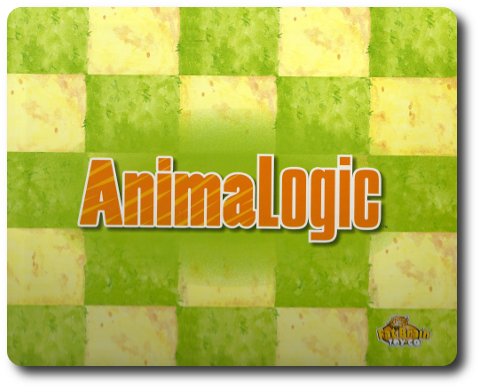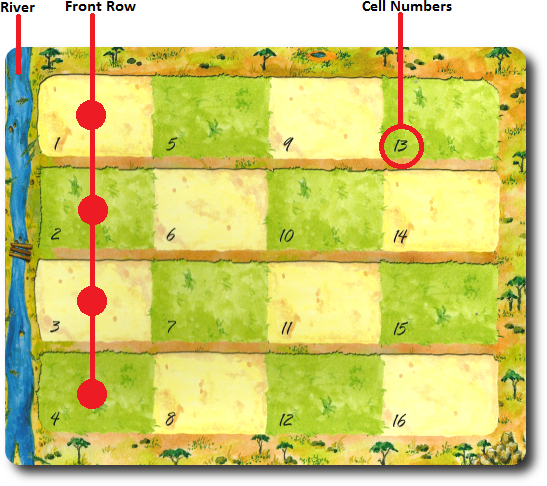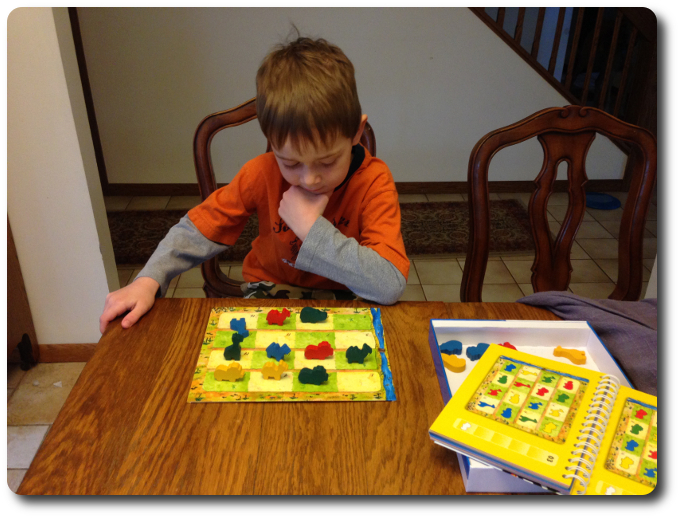
The Basics:
- For ages 5 and up
- For 1 or more players
- Variable game length
Geek Skills:
- Logical & Critical Decision Making
- Pattern/Color Matching
- Visuospatial Skills
Learning Curve:
- Child – Easy
- Adult – Easy
Theme & Narrative:
- Help the animals cross the river in an orderly fashion to avoid a stampede!
Endorsements:
- Gamer Geek rejected!
- Parent Geek approved!
- Child Geek mixed!
Overview
Your animal park has been in a drought for over 8 months. When the rain clouds appeared on the horizon, even the animals looked hopeful. But when the steady downpour kept getting harder and harder, hopes changed into fears. The river is rising and you have been sent out into the park to rescue the animals. The majority of animals have already been saved, but a few remain. The lions, camels, giraffes, and hippos have been gathered together, but there is only a small bridge to safety that is dangerously close to being swept downstream by the flooded river. You must cross the animals quickly and in an orderly fashion before they stampede. Your mother told you there would be days like this…
AnimaLogic, designed by Mark Engelberg and published by Fat Brain Toys, is comprised of 16 Animal meeples (4 “Lions”, 4 “Hippos”, 4 “Giraffes”, and 4 “Camels”, in 4 different colors each), 1 game board, and 1 puzzle book (which includes the puzzle solutions). The Animal meeples are simply excellent. Chunky, wooden, and very colorful. The bright colors (yellow, blue, green, and red) immediately draw the eye and you can’t help yourself from picking them up for a closer inspection. The game board is very thick and durable with a glossy finish. The puzzle book is spiraled and printed on thick paper. Top quality throughout.
Puzzle Set Up
AnimaLogic can be played solo or as a group. Regardless, only 1 puzzle is being solved at a time. To set up the puzzle, first place the game board in the middle of the playing area.
Second, determine which puzzle you or your group wants to solve. Like most Puzzle games, there are multiple levels of difficulty. In this case, the difficulty is measured in “Lions”. One “Lion” is the easiest and five “Lions” is the most difficulty. There are 60 puzzles to choose from.

Example of 1 of the 60 possible puzzles to challenge you
Third, set up the game board as shown in the puzzle book. If it helps, orientate the river on the game board to match the puzzle book picture. Place each colored Animal meeple so it’s in the matching cell number on the game board.

That’s it! Time to save some animals!
A “Wild” Predicament
The goal is simple: save the animals. However, the player must go about saving said animals in a logical and organized way. There are only 3 rules to follow.
- Only the Animal meeple closest to the river in each row can go over the bridge (animals cannot jump over each other or shift rows).
- Only 1 Animal meeple may cross the river at a time (in order to avoid a stampede).
- The next Animal meeple to follow the last Animal meeple to cross the river MUST be the SAME COLOR or the SAME SPECIES. For example, a red “Lion” Animal meeple could follow any other colored “Lion” Animal meeple or any Animal meeple that was red.
Using these rules, the player can take as long as they like to move each Animal meeple across the river, one at a time, until all of the Animal meeples are safe.
Multiple Solutions
The solution to each of the 60 puzzles can be found in the puzzle book. If the Animal meeples are placed on the game board correctly, the puzzle solution lists which colored Animal meeple should move first by cell number, and then second, and so on. Essentially, it’s a step-by-step summary of how the puzzle is solved.

But the solution listed is not the only solution. It’s perfectly possible that a puzzle might have more than one solution. The puzzle book only offers 1 solution per puzzle, but a player can always find another (and possibly better) way to save the animals.
Once the puzzle is solved, select a new puzzle and set up the game board as shown. Rinse, repeat, and have fun.
Game Variants
The designer of the game, Mark Engelberg, contacted me in July of 2015 with some interesting news. Turns out the rules for AnimaLogicare incomplete. A small number of game variants were excluded in the final publication. In Mr. Engelberg’s own words…
“I thought [the game variants] really extended the value of [AnimaLogic]. More importantly, these rules give kids a motivation to create and share their own content, which is something I’m rather passionate about.”
I read the excluded rules and shared them with others who have enjoyed the game. All the players thought the same thing: these game variants should have been included. Since they were not, I will provide them here for you. Mr. Engelberg and I hope you enjoy them.
Animal Instinct
Place all the Animal meeples in the cloth bag and draw them out randomly to create the initial puzzle set up. The game is now played as normal except for one very important new rule: absolutely no backtracking or taking back a move. Players must think critically and logically about their current move and the moves to come. There is no solution (since the puzzle is random) and players are encouraged to work on the puzzle until they feel no additional turns can be made. The player then records their score (the number of Animal meeples still remaining) and tries again with a new random puzzle. In the words of Mr. Engelberg…
“By playing in this way, you’ll really stretch your ability to look several moves ahead, and when you can’t see perfectly how it will play out, you’ll develop intuition that will help you identify which pieces are the bottlenecks and which can be safely removed. Track your scores and you’ll see your abilities growing over time. As you become an expert player, you’ll find that about 80% of the puzzles created in this way are solvable with a perfect score of 0.”
The goal is always to get a score of 0 or as low as possible. It’s suggested that 4 random puzzles be played in a row, adding the results to determine the player’s final score.
Going Social
This game variant piggybacks off the random puzzle set up. Before attempting to solve the random puzzle, take a quick picture and share it on your favorite social media network. Give the puzzle a name and make sure the picture is clear enough to allow others to duplicate the puzzle set up. Then attempt to solve it using the Animal Instinct rule game variant. Post your final score and challenge friends and family to beat it!
To learn more about AnimaLogic, visit the game’s web page.
Prediction
Puzzle games are a mixed bag pretty much for everyone I have ever played with or observed. Individuals usually start out pretty optimistic and enjoy the challenge. As the puzzles become more difficult, enthusiasm begins to wane for everyone put puzzle enthusiasts. For that reason, I think the most positive endorsements will come from our puzzle-minded players. I also think all the Child Geeks will enjoy the Animal meeples. They are pretty cool. For the Parent Geeks, I think they’ll find the puzzles challenging and worthwhile. They might fully approve AnimaLogic simply based on the game’s perceived educational value. For the Gamer Geeks, I don’t think we’ll see them endorse the game, but I am certain they will applaud it. Any “game” you can only play once, like a Puzzle game, tend to be respected but not loved.
Teaching AnimaLogic is best done by sitting down with the new player and going through puzzles 1 through 5. These first 5 puzzles do a great job of showing all the different ways the players will have to think through their moves. Note that the game is easy to learn (there are only 3 rules to follow), but the difficulty curve is pretty steep when it comes to the different puzzles. For example, a player can figure out puzzle 1 and puzzle 2 without too much trouble, but puzzle 3 will cause them to pause and scratch their head. Everything is solvable and the player is always welcome to take a quick look at the back of the puzzle book for some helpful hints.
AnimaLogic can be played with only one person or with a group. If played with a group, you are working on the same puzzle together. This allows Parent Geeks to enjoy the challenge of the puzzle with their Child Geeks and have some quality time, as well. There is nothing about the game that is competitive other than attempting to solve the puzzle before your patience runs out. Feel free to work through it as a group or alone. There is no wrong way to go about it. Individuals who have difficulty distinguishing colors will be at a disadvantage playing this game.
And so, after teaching the game to my little geeks, I asked them their thoughts on AnimaLogic so far.
“I think we’ve played a game like this before. I think they are fun…for awhile.” ~ Liam (age 9)
“I like Puzzle games! Can I play this whenever I want?” ~ Nyhus (age 6)
“Look! A lion! Raarr! The lion is going to eat the hippo…” ~ Ronan (age 4)
The publisher suggests that Child Geeks as young as 5-years-old can play this game. I’m going to see if I can get a 4-year-old to enjoy it, too. As for my two older little geeks, neither one will have any problems learning and playing the game. My oldest, who is most definitely NOT a Puzzle game lover, will tolerate it. My 6-year-old is going to very much enjoy the challenge. Let’s play AnimaLogic and see if it’s a creative good time or smells of wet hippo butt.
Final Word
To put it simply, the Child Geeks who enjoyed puzzles enjoyed AnimaLogic. Those who did not quickly came to the conclusion that there were more entertaining things they could be doing with their time. For example, picking up the backyard. As predicted, only those Child Geeks who naturally enjoy a quiet challenge of logical and critical thinking stuck with and approved the game. All other Child Geeks did not. My 4-year-old understood the rules, but couldn’t get past the first puzzle. According to him, “This is hard, Daddy. Can I play with the animals?” Regardless of how an individual Child Geek felt about the game, they all agreed that the Animal meeples were “pretty cool”. The game received mixed approvals, with thumbs-up from the puzzle lovers and an ugly look from everyone else.

My 6-year-old quietly considers his next move…
The Parent Geeks also tended to be polarized when it came to their personal feelings about puzzles in general, but they all agreed that AnimaLogic was a good Puzzle game. According to one Parent Geek, “I think some of these puzzles are really hard, but I love the logic behind them and that I can work on the puzzle with my kids.” The Parent Geeks approved the game, not because all of them thought it was fun, but because all of them saw the benefit of putting the game in front of their family members. Another Parent Geek said, “Anything I can do to get my kid to look away from the TV gets my vote.” Positive votes all-around from the Parent Geek crowd.
The Gamer Geeks all appreciated the logical and critical thinking that was necessary to play the game and the quality of the components. They did not approve the game, however. According to one Gamer Geek, “I’ve said it once and I’ll say it again. Puzzle games are great, but once you solve them, they have no value.” All the Gamer Geeks agreed the puzzles were challenging but never thought for a moment it was worth putting on their gaming table.
AnimaLogic is a pretty good time, but I must stress that you have to enjoy logic puzzles. The pretty colors and wonderful meeples will draw the eye and a player’s attention. Have no fear about getting people interested. After the first puzzle, expect to see enthusiasm quickly spiral downward or start slowly increasing. Puzzle loves will enjoy the game, but that’s about it. Parent Geeks will enjoy it, but not necessarily because it’s a fun time. AnimaLogic, like all Puzzle games, are very specialized and focus only on one thing: making you think really, really hard. If you like that kind of challenge, then AnimaLogic is the logical choice for you.
This game was given to Father Geek as a review copy. Father Geek was not paid, bribed, wined, dined, or threatened in vain hopes of influencing this review. Such is the statuesque and legendary integrity of Father Geek.




Pingback: Today in Board Games Issue #169 - Rolling Dice & Taking Names - Today in Board Games
Pingback: In Review: Father Geek’s Monthly Newsletter (May 2014) » Father Geek